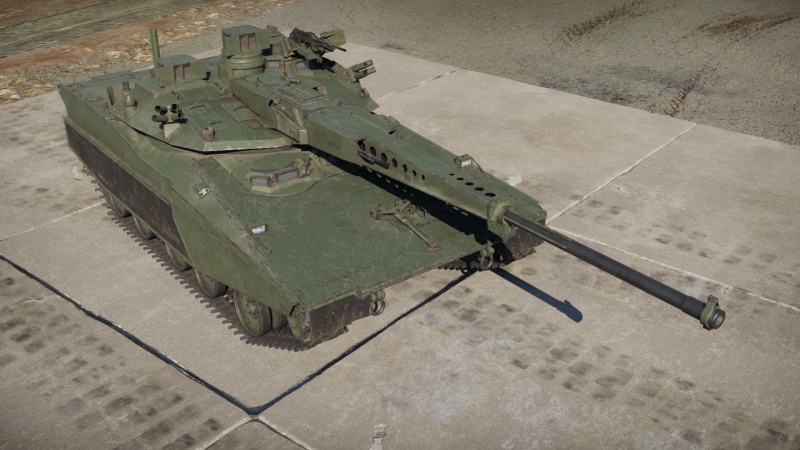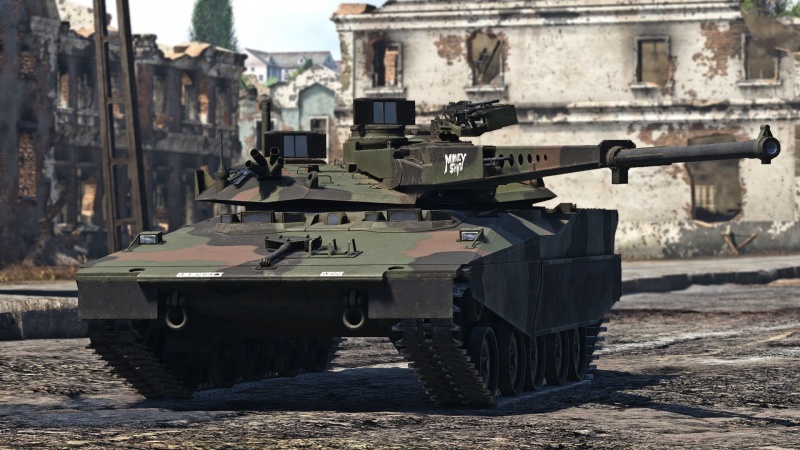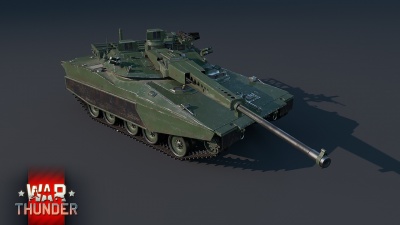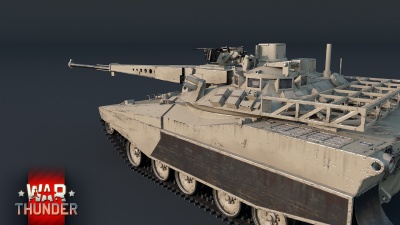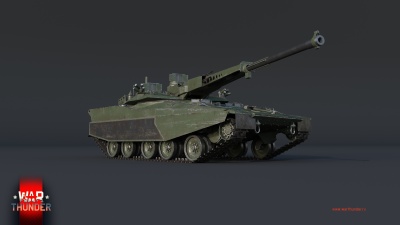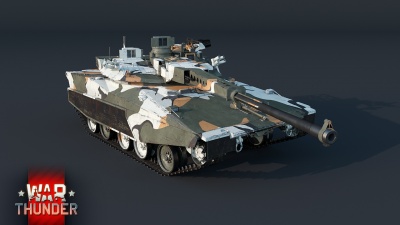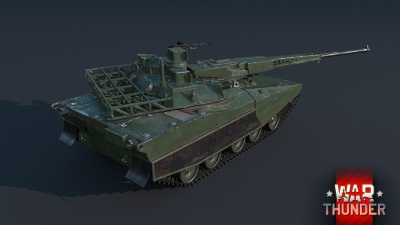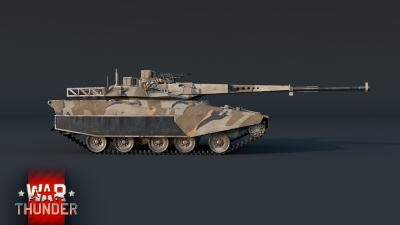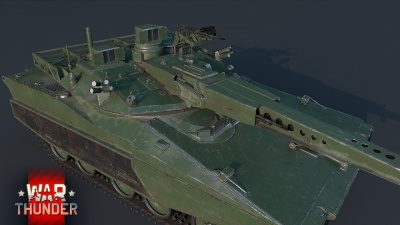Difference between revisions of "HSTV-L"
m (→Pros and cons) (Tag: Visual edit) |
U103691029 (talk | contribs) m (→Main armament: Autoloader) (Tag: Visual edit) |
||
| (77 intermediate revisions by 22 users not shown) | |||
| Line 1: | Line 1: | ||
| − | {{Specs-Card|code=us_hstv_l}} | + | {{Specs-Card |
| + | |code=us_hstv_l | ||
| + | |images={{Specs-Card-Image|GarageImage_{{PAGENAME}}.jpg|ArtImage_{{PAGENAME}}.jpg}} | ||
| + | }} | ||
== Description == | == Description == | ||
<!-- ''In the description, the first part should be about the history of the creation and combat usage of the vehicle, as well as its key features. In the second part, tell the reader about the ground vehicle in the game. Insert a screenshot of the vehicle, so that if the novice player does not remember the vehicle by name, he will immediately understand what kind of vehicle the article is talking about.'' --> | <!-- ''In the description, the first part should be about the history of the creation and combat usage of the vehicle, as well as its key features. In the second part, tell the reader about the ground vehicle in the game. Insert a screenshot of the vehicle, so that if the novice player does not remember the vehicle by name, he will immediately understand what kind of vehicle the article is talking about.'' --> | ||
| − | + | The '''High Survivability Test Vehicle – Lightweight (HSTV-L)''' is a light gun system testbed developed in the late 1970s as part of the larger joint U.S. Army and U.S. Marine Corps – Advanced Anti-Armour Vehicle Evaluation (ARMVAL) program, which aimed to explore concepts for future armoured fighting vehicles with a focus on lightweight vehicles. The HSTV-L was created to operationally test the concept of using high speed to enhance a vehicle's survivability rather than heavy armour. It was also used to test a number of new tank technologies, the most notable of which was an automatic main gun - a 75 mm ARES XM274 smoothbore rapid-fire hyper-velocity tank gun. The whole system was nicknamed ELKE (Elevated Kinetic Energy Vehicle). The ARES concept was to fire several high-velocity armour-piercing rounds at an enemy main battle tank (MBT) in a short period of time in order to break through its composite armour. Only one HSTV-L testbed was built and tested until the mid-1980s. Unfortunately, by the time the HSTV-L was tested, the U.S. Army had determined that the ARES cannon would be ineffective against newer Soviet tanks and decided that the 105 mm Royal Ordnance L7 tank gun was the minimum calibre for light gun systems. The Marines were also not confident that the ARES would be effective, particularly in their beach-landing role in breaking through enemies' heavy defences. | |
| − | + | ||
| − | The ''' | + | Introduced in [[Update "Starfighters"]], the HSTV-L offers a unique gameplay experience in top-tier U.S. Army ground forces. The HSTV-L, which has a two-plane fully automatic stabilisation system, laser rangefinder, thermal imaging equipment, and an autoloader that can reload in as little as 1.5 seconds, holds a lot of potential as a hard-hitting flanking vehicle on a heavily contested battlefield. Because of the unusual main gun arrangement, the HSTV-L also provides excellent gun depression if the battlefield is mountainous. However, due to the small calibre of its main gun, it may struggle to engage some MBTs frontally, limiting its overall versatility. |
== General info == | == General info == | ||
=== Survivability and armour === | === Survivability and armour === | ||
| + | {{Specs-Tank-Armour}} | ||
<!-- ''Describe armour protection. Note the most well protected and key weak areas. Appreciate the layout of modules as well as the number and location of crew members. Is the level of armour protection sufficient, is the placement of modules helpful for survival in combat? If necessary use a visual template to indicate the most secure and weak zones of the armour.'' --> | <!-- ''Describe armour protection. Note the most well protected and key weak areas. Appreciate the layout of modules as well as the number and location of crew members. Is the level of armour protection sufficient, is the placement of modules helpful for survival in combat? If necessary use a visual template to indicate the most secure and weak zones of the armour.'' --> | ||
| − | + | The HSTV-L is a very lightly-armoured vehicle. Depending on where you get shot you might lose 1 crew member but you will still be alive. If you get shot on the left side of the vehicle from the front, the chances of your ammo rack detonating greatly increases. Best case scenario for this vehicle is to not get hit in the first place. | |
{| class="wikitable" | {| class="wikitable" | ||
| Line 16: | Line 20: | ||
! Armour !! Front (Slope angle) !! Sides !! Rear !! Roof | ! Armour !! Front (Slope angle) !! Sides !! Rear !! Roof | ||
|- | |- | ||
| − | | Hull || | + | | Hull || 25.4 mm (80°) ''Upper Glacis'' <br> {{annotation|25.4 mm|Estimated through calculation of effective thickness at angle.}} (55°) ''Lower Glacis (Upper Part)'' <br> {{annotation|25.4 mm|Estimated through calculation of effective thickness at angle.}} (78°) ''Lower Glacis (Lower Part)'' |
| + | | 25.4 mm ''Upper Sponson Side'' <br> 19 mm ''Lower Sponson Side'' <br> 38.1 mm ''Lower Hull Side'' | ||
| + | | 25.4 mm || 19 mm ''Engine Compartment'' <br> 5 mm ''Radiator Vents'' | ||
| + | |- | ||
| + | | Turret || 25.4 mm ''Turret front'' <br>25.4 mm ''Gun mantlet'' || 25.4 mm || 25.4 mm || 25.4 mm | ||
|- | |- | ||
| − | | | + | | Cupola || colspan="4" | 25.4 mm |
|- | |- | ||
| − | | | + | |Additional Armour |
| + | || {{annotation|25.4 mm|Estimated through calculation of effective thickness at angle.}} (80°) ''Upper Glacis'' || {{annotation|25.4 mm|Estimated through calculation of effective thickness at angle.}} ''Frontal Sponson Side (Upper & Lower)'' <br> 12.7 mm ''Frontal Sideskirts'' <br> 8 mm ''Rear Sideskirts'' || colspan="2" |N/A | ||
|- | |- | ||
|} | |} | ||
| − | '''Notes:''' | + | '''Notes:''' |
| − | + | ||
| + | * Lower glacis (both parts) is variable thickness armour. | ||
| + | * Upper glacis and frontal sponson sides appliqué armour is variable thickness armour. | ||
=== Mobility === | === Mobility === | ||
| + | {{Specs-Tank-Mobility}} | ||
<!-- ''Write about the mobility of the ground vehicle. Estimate the specific power and manoeuvrability, as well as the maximum speed forwards and backwards.'' --> | <!-- ''Write about the mobility of the ground vehicle. Estimate the specific power and manoeuvrability, as well as the maximum speed forwards and backwards.'' --> | ||
| − | |||
| − | {{tankMobility}} | + | {{tankMobility|abMinHp=1,007|rbMinHp=575}} |
| + | |||
| + | The HSTV-L has a very good power-to-weight ratio making the vehicle decently fast. The vehicle utilizes a 648 HP gas turbine engine. The HSTV-L is very manoeuvrable due to the gas turbine engine and can get to flanking spots early in the game. However, caution must be taken in regards to the loud engine noise, especially when trying to avoid drawing the attention of enemy players to you. | ||
| + | |||
| + | === Modifications and economy === | ||
| + | {{Specs-Economy}} | ||
| + | |||
| + | '''<big>Unlock order recommendations</big>''' | ||
| + | |||
| + | The order of modifications should be well thought out. Below is a guide of which modifications to unlock first, but it is just a recommendation and can be modified or adapted depending on the tank commander's preferences. | ||
| + | |||
| + | '''Tier 1''' | ||
| + | |||
| + | Tier 1 only has useful modifications but the number one priority should be parts which allows the tank to repair during battle, something that comes in handy in a majority of battles. After that tracks is something that could be researched second as its mobility is more reliant on the tracks upgrade than the firepower is on horizontal drive. | ||
| + | |||
| + | '''Tier 2''' | ||
| + | |||
| + | Moving on to tier 2, this tier is harder to pick modifications from because in general they are less useful modifications, but only two are needed before moving to tier 3. FPE and adjustment of fire are the likeliest candidates except in cases where the goal is to use the scouting ability to spawn planes, in which either of the two could be replaced by airstrike. It's best to move on to tier 3 after two tier 2 modifications are researched. | ||
| + | |||
| + | '''Tier 3''' | ||
| + | |||
| + | In tier 3 it gets more interesting with a number of useful modifications; three modifications are needed to get to tier 4. All the modifications in this tier are useful so some hard choices have to be made. Due to a decent stock elevation speed the elevation mechanism mod isn't strictly necessary and can be put off until later. Smoke grenades are good for concealing the vehicle to make a hasty escape or try to prevent the enemy from hitting the tank, the laser rangefinder is useful for making accurate shots at range which is also very important as the gun does not have much penetration so well aimed shots are necessary, crew replenishment is useful as always, and filters are beneficial to the mobility. It's recommended to unlock laser rangefinder and smoke grenades and then choose between filters and crew replenishment before then moving on to tier 4. | ||
| + | |||
| + | '''Tier 4''' | ||
| + | |||
| + | The most important modifications in tier 4 are NVD to give access to thermal sights for easier spotting of enemies and also the engine modification which greatly increases mobility. | ||
| + | |||
| + | '''Finishing up''' | ||
| + | |||
| + | After tier 4 is unlocked and the priority modifications there are unlocked it is time to clean up the remaining modifications. The order of unlocking modifications at this point is less important but there are a few that should be left until last - suspension and brake system which are generally the least important modifications on any given ground vehicle. | ||
== Armaments == | == Armaments == | ||
| + | {{Specs-Tank-Armaments}} | ||
=== Main armament === | === Main armament === | ||
| + | {{Specs-Tank-Weapon|1}} | ||
<!-- ''Give the reader information about the characteristics of the main gun. Assess its effectiveness in a battle based on the reloading speed, ballistics and the power of shells. Do not forget about the flexibility of the fire, that is how quickly the cannon can be aimed at the target, open fire on it and aim at another enemy. Add a link to the main article on the gun: <code><nowiki>{{main|Name of the weapon}}</nowiki></code>. Describe in general terms the ammunition available for the main gun. Give advice on how to use them and how to fill the ammunition storage.'' --> | <!-- ''Give the reader information about the characteristics of the main gun. Assess its effectiveness in a battle based on the reloading speed, ballistics and the power of shells. Do not forget about the flexibility of the fire, that is how quickly the cannon can be aimed at the target, open fire on it and aim at another enemy. Add a link to the main article on the gun: <code><nowiki>{{main|Name of the weapon}}</nowiki></code>. Describe in general terms the ammunition available for the main gun. Give advice on how to use them and how to fill the ammunition storage.'' --> | ||
{{main|XM274 (75 mm)}} | {{main|XM274 (75 mm)}} | ||
| − | |||
{| class="wikitable" style="text-align:center" width="100%" | {| class="wikitable" style="text-align:center" width="100%" | ||
|- | |- | ||
| − | ! colspan="5" | [[XM274 (75 mm)|75 mm XM274]] || colspan="5" | Turret rotation speed (°/s) | | + | ! colspan="5" | [[XM274 (75 mm)|75 mm XM274]] || colspan="5" | Turret rotation speed (°/s) || Reloading rate (seconds) |
|- | |- | ||
! Mode !! Capacity !! Vertical !! Horizontal !! Stabilizer | ! Mode !! Capacity !! Vertical !! Horizontal !! Stabilizer | ||
! Stock !! Upgraded !! Full !! Expert !! Aced | ! Stock !! Upgraded !! Full !! Expert !! Aced | ||
| − | ! | + | !Autoloader |
|- | |- | ||
! ''Arcade'' | ! ''Arcade'' | ||
| − | | rowspan="2" | 26 || rowspan="2" | -17°/+45° || rowspan="2" | ±180° || rowspan="2" | Two-plane || | + | | rowspan="2" | 26 || rowspan="2" | -17°/+45° || rowspan="2" | ±180° || rowspan="2" | Two-plane || 54.3 || 75.1 || 91.2 || 100.9 || 107.3 || rowspan="2" | 1.50 |
|- | |- | ||
! ''Realistic'' | ! ''Realistic'' | ||
| − | | 33.9 || | + | | 33.9 || 39.9 || 48.5 || 53.6 || 57.0 |
|- | |- | ||
|} | |} | ||
==== Ammunition ==== | ==== Ammunition ==== | ||
| − | { | + | {{:XM274 (75 mm)/Ammunition|XM885}} |
| − | |||
| − | |||
| − | |||
| − | |||
| − | |||
| − | |||
| − | |||
| − | |||
| − | | XM885 | ||
| − | |||
| − | |||
| − | |||
| − | |||
| − | |||
| − | |||
| − | |||
| − | |||
| − | |||
| − | |||
| − | |||
| − | |||
| − | |||
| − | |||
| − | |||
| − | |||
| − | |||
| − | |||
| − | |||
==== [[Ammo racks]] ==== | ==== [[Ammo racks]] ==== | ||
| − | + | [[File:Ammoracks_{{PAGENAME}}.jpg|right|thumb|x250px|[[Ammo racks]] of the {{PAGENAME}}]] | |
| + | <!-- '''Last updated: 2.1.0.82''' --> | ||
{| class="wikitable" style="text-align:center" | {| class="wikitable" style="text-align:center" | ||
|- | |- | ||
| Line 93: | Line 107: | ||
! 1st<br>rack empty | ! 1st<br>rack empty | ||
! 2nd<br>rack empty | ! 2nd<br>rack empty | ||
| − | |||
| − | |||
| − | |||
| − | |||
! Visual<br>discrepancy | ! Visual<br>discrepancy | ||
|- | |- | ||
| − | | '''26''' || | + | | '''26''' || 7 ''(+19)'' || 1 ''(+25)'' || No |
|- | |- | ||
|} | |} | ||
| + | '''Notes:''' | ||
| + | |||
| + | * Rack 2 is a ready rack, so although shells deplete from that rack after firing, it will refill from rack 1. | ||
=== Machine guns === | === Machine guns === | ||
| + | {{Specs-Tank-Weapon|2}} | ||
| + | {{Specs-Tank-Weapon|3}} | ||
<!-- ''Offensive and anti-aircraft machine guns not only allow you to fight some aircraft but also are effective against lightly armoured vehicles. Evaluate machine guns and give recommendations on its use.'' --> | <!-- ''Offensive and anti-aircraft machine guns not only allow you to fight some aircraft but also are effective against lightly armoured vehicles. Evaluate machine guns and give recommendations on its use.'' --> | ||
{{main|M240 (7.62 mm)}} | {{main|M240 (7.62 mm)}} | ||
| − | + | ||
| + | The HSTV-L has 2 M240 machine guns. One is fixed to the gun mantlet and the other is mounted on the Commander's cupola. These machine guns can be used to mark enemies for your allies and can also be used to shoot down some lighter aircraft, but be careful as shooting them will give away your location and can result in them strafing and destroying your vehicle. | ||
{| class="wikitable" style="text-align:center" width="50%" | {| class="wikitable" style="text-align:center" width="50%" | ||
| Line 114: | Line 130: | ||
! Mount !! Capacity (Belt) !! Fire rate !! Vertical !! Horizontal | ! Mount !! Capacity (Belt) !! Fire rate !! Vertical !! Horizontal | ||
|- | |- | ||
| − | | Coaxial || 1,600 (200) || | + | | Coaxial || 1,600 (200) || 941 || N/A || N/A |
|- | |- | ||
| − | | Pintle || 1,600 (200) || | + | | Pintle || 1,600 (200) || 941 || -10°/+69° || -180°/+20° |
|- | |- | ||
|} | |} | ||
| Line 122: | Line 138: | ||
== Usage in battles == | == Usage in battles == | ||
<!-- ''Describe the tactics of playing in the vehicle, the features of using vehicles in the team and advice on tactics. Refrain from creating a "guide" - do not impose a single point of view but instead give the reader food for thought. Describe the most dangerous enemies and give recommendations on fighting them. If necessary, note the specifics of the game in different modes (AB, RB, SB).'' --> | <!-- ''Describe the tactics of playing in the vehicle, the features of using vehicles in the team and advice on tactics. Refrain from creating a "guide" - do not impose a single point of view but instead give the reader food for thought. Describe the most dangerous enemies and give recommendations on fighting them. If necessary, note the specifics of the game in different modes (AB, RB, SB).'' --> | ||
| − | + | The HSTV-L is a light tank with a quick ready-rack reload, making it adept at dealing with multiple enemies in ambush situations. It can achieve a very good top speed thanks to its light weight and has a similarly good turning ability. With this mobility (which is on par with that of top MBTs), the HSTV-L can achieve desirable early-game positions and move quickly around the map when necessary. | |
| − | + | Like most light tanks, this vehicle is lacking in the protection department. It has thin armour in all directions, which is not backed up by any spaced or composite protection, and is susceptible to overpressure damage. In some situations, the armour may be thin enough that kinetic rounds overpenetrate and pass straight through the vehicle without causing much damage. The highly-angled armour can also sometimes bounce shots. In most cases though, the HSTV-L cannot be counted on to sustain heavy fire. | |
| − | + | ||
| − | + | This tank is fairly unique in that it is equipped with an autoloader that can fire every 1.5 seconds, without ever needing to stop to replenish a ready-rack.The shell itself, an APFSDS round, is decent, but may have trouble penetrating the frontal armour of top MBTs. This combined with the vehicle's poor armour means that head-on attacks are rarely advisable, but with the quick reload, multiple shots into an enemy's sides or rear will be very effective. | |
| − | + | ||
| − | + | The HSTV-L is better suited to firing at enemies without their noticing--from ambush positions, from the flanks, and from behind corners. The vehicle's great mobility will aid with this playstyle. Indeed, its mobility is what makes the HSTV-L great on urban maps. Furthermore, in ambush situations the tank is able to easily deal with multiple enemies thanks to its fast ready-rack reload. This tank has a 45 degree gun elevation and a 17 degree gun depression. This gun depression is extremely powerful, and makes the vehicle very effective at hill camping and at firing from behind ridgelines. A thermal sight in both gunner and commander/binocular views makes the HSTV-L a great scouting vehicle. It is recommended to use the vehicle's high mobility to aid in scouting enemies for teammates to locate and destroy. | |
| − | |||
| − | |||
| − | |||
| − | |||
| − | |||
| − | |||
| − | |||
| − | |||
| − | |||
| − | |||
| − | |||
| − | |||
| − | |||
| − | |||
| − | |||
| − | |||
| − | |||
| − | |||
| − | |||
| − | |||
| − | |||
| − | |||
| − | |||
| − | |||
| − | |||
| − | |||
| − | |||
| − | |||
| − | |||
| − | |||
| − | |||
| − | |||
| − | |||
| − | |||
| − | |||
=== Pros and cons === | === Pros and cons === | ||
| Line 170: | Line 151: | ||
'''Pros:''' | '''Pros:''' | ||
| − | * | + | * Thanks to the autoloader, the cannon has a very high rate of fire |
| − | + | * Due to its light armour some kinetic rounds may over penetrate, leaving it undamaged | |
| − | * Due to its light armour | + | * Excellent in urban combat where side shots are much more effective |
| − | * Excellent urban | + | * Internal 5 mm armour can help protect crew from spalling |
| − | + | * Thermal sights for both the gunner and the commander make it a great scouting vehicle especially with its scout UAV, also with thermals | |
| − | * Internal | + | ** Its scout UAV has better thermals than the HSTV-L itself |
| + | * Up to 45° elevation and -30° depression over the sides (-17° depression to the front, -6° depression when facing rear) | ||
| + | * Very good gun handling | ||
| + | * Turret has only one crew member, the commander, and the breech is small | ||
| + | * Excellent mobility, allowing it to keep up with and even outpace MBTs | ||
'''Cons:''' | '''Cons:''' | ||
| − | |||
* Commander's cupola can be penetrated by heavy machine gun fire | * Commander's cupola can be penetrated by heavy machine gun fire | ||
| − | * Limited | + | * Limited ammo selection and capacity |
| − | + | * APFSDS round has low penetration and has problems penetrating frontal armour of some MBTs | |
| − | * APFSDS round has problems penetrating frontal armour of | + | * The XM855 APFSDS dart causes minimal damage to modules or crew members after penetration due to its calibre (reduced spall) |
| + | * Prone to overpressure | ||
| + | * Does not have access to a heavy machine gun | ||
== History == | == History == | ||
<!-- ''Describe the history of the creation and combat usage of the vehicle in more detail than in the introduction. If the historical reference turns out to be too long, take it to a separate article, taking a link to the article about the vehicle and adding a block "/History" (example: <nowiki>https://wiki.warthunder.com/(Vehicle-name)/History</nowiki>) and add a link to it here using the <code>main</code> template. Be sure to reference text and sources by using <code><nowiki><ref></ref></nowiki></code>, as well as adding them at the end of the article with <code><nowiki><references /></nowiki></code>. This section may also include the vehicle's dev blog entry (if applicable) and the in-game encyclopedia description (under <code><nowiki>=== In-game description ===</nowiki></code>, also if applicable).'' --> | <!-- ''Describe the history of the creation and combat usage of the vehicle in more detail than in the introduction. If the historical reference turns out to be too long, take it to a separate article, taking a link to the article about the vehicle and adding a block "/History" (example: <nowiki>https://wiki.warthunder.com/(Vehicle-name)/History</nowiki>) and add a link to it here using the <code>main</code> template. Be sure to reference text and sources by using <code><nowiki><ref></ref></nowiki></code>, as well as adding them at the end of the article with <code><nowiki><references /></nowiki></code>. This section may also include the vehicle's dev blog entry (if applicable) and the in-game encyclopedia description (under <code><nowiki>=== In-game description ===</nowiki></code>, also if applicable).'' --> | ||
| − | '' | + | '''<big>Development</big>''' |
| + | |||
| + | The High Survivability Test Vehicle - Lightweight, shortened to HSTV-L, was a light tank project that was developed in the 1970s and 1980s. It was funded by the Defense Advanced Research Projects Agency (DARPA) and built by the AAI Corporation. The prototype was completed in September 1979 and began field trials soon after. After the field trials the HSTV-L was used for testing of the fire control system (FCS) with different stabilization algorithms tested as well as the hunter-killer sights. The HSTV-L was not chosen for production by the Army or the Marine Corps and was cancelled in 1981. It was later developed into the Rapid Deployment Force Light Tank (RDF/LT). | ||
| + | |||
| + | '''Design''' | ||
| + | |||
| + | '''General''' | ||
| + | |||
| + | The HSTV-L design was based around an incredibly low profile hull and turret with very shallow angles on the frontal portion, in order to deflect projectiles fired at it. The HSTV-L had a crew of 3, with the driver and gunner side by side in the hull front and the commander in the left side of the turret, all of whom sat semi-reclined. All 3 crew members had the ability to fire the gun and both the gunner and driver's position could drive the vehicle. The vehicle had a length of 8.528 m with gun forward and the hull had a length of 5.918 m. The height was only 2.414 m including the equipment on the turret roof, being 1.994 m to the top of the turret and 1.422 m to the top of the hull. The width was 2.794 m. The vehicle had a combat weight of 14.5 tonnes or up to 17.0 tonnes when equipped with an appliqué armour package. During testing the HSTV-L was fitted with additional equipment for data collection and weighed 20.45 tonnes. The HSTV-L could be airlifted, underslung, by a CH-53 Sea Stallion helicopter when at the weight of 14.5 tonnes. | ||
| + | |||
| + | '''Mobility and Power''' | ||
| + | |||
| + | The HSTV-L was propelled by a 650 horsepower (485 kilowatt) Avro-Lycoming gas turbine powerplant and an Allison X-300-4A transmission with four forward and two reverse gears. The transmission had a torque converter. There were five road wheels on each side and the tracks were 450 mm wide. The suspension was built by National Water Lift, being hydropneumatic but not variable; in other words the height could not be adjusted. The ground clearance of the HSTV-L was 0.508 m. The HSTV-L could pivot in place while in neutral gear, and it carried a fuel load of 409 liters giving it a cruising range of 160 km. It could accelerate from 0 to 48 km/h in 11.8 seconds and had a maximum speed of 83.68 km/h. | ||
| + | |||
| + | In addition to the main propulsion system there were two 250 ampere generators providing auxiliary power as well as a 60 gpm hydraulic pump. The hydraulic pump was used to power an oil cooler fan mounted in the engine compartment as well as the gun control system and automatic loading system. | ||
| + | |||
| + | '''Armament and FCS''' | ||
| + | |||
| + | The main armament of the HSTV-L was an ARES 75 mm XM274 gun mounted in a rotating turret. 26 rounds of ammunition were provided of both depleted-uranium APFSDS-T and multi-fléchette anti-aircraft rounds. The gun was loaded by an automatic loading system which provided the HSTV-L with a high rate of fire. | ||
| + | |||
| + | Secondary armament was provided by a coaxial 7.62 mm M240 machine gun and a second 7.62 mm M240 machine gun pintle-mounted on the commander's cupola. A total of 3,200 rounds of 7.62 mm ammunition was split between the two machine guns. | ||
| + | |||
| + | The turret could rotate a full 360 degrees at a speed of 57 degrees per second. The gun could elevate 45 degrees but the depression depended on which direction the turret faced; over the front the gun could depress 17 degrees, 30 degrees over the side, and 6 degrees over the rear of the vehicle. Manual backup was provided for turret traverse and gun elevation but the rate at which they moved was much slower when manual than with power. The main gun was two-plane stabilized, with both the stabilization and gun control systems having been produced by Cadillac Gage. | ||
| + | |||
| + | The hunter/killer fire control system (FCS) was designed and built by Texas Instruments. The commander received a stabilized commander's independent thermal viewer (CITV) which could rotate independently of the turret and included both TV and thermal imaging. The gunner also received a stabilized sight, though this one was slaved to the gun, which included thermal and TV imaging as well, along with an eye safe CO2 laser rangefinder built by Raytheon. This hunter/killer system allowed the commander to locate a target with the hunter sight. Once a target was located the gunner would use his killer sight to fire on the target while the commander began to search for the next target. The fire control system (FCS) used the sights, crosswind sensor, muzzle reference system, vertical reference system, and laser rangefinder to automatically determine the firing solution, leaving the gunner only to fire the gun. The fully stabilized main gun along with advanced FCS allowed the HSTV-L a high first hit probability and high accuracy on the move. | ||
| + | |||
| + | The driver and gunner are given a screen that displays the imaging of the hunter sight which allows them to operate independently of a vehicle commander if necessary. Theoretically, the HSTV-L could be controlled entirely by only one crew member from either the driver or gunner's position since both had driving and gunnery controls. | ||
| + | |||
| + | === [[wt:en/news/6711-development-hstv-l-view-of-tomorrow-en|Devblog]] === | ||
| + | By the mid 1970s, the US military initiated a series of studies which looked into the development of new concepts and designs for tanks which combined good firepower and survivability. The latter of which was to be achieved through a smaller size, rather than heavy armour protection. | ||
| + | |||
| + | As at the time, both the US Army and USMC were looking into possible replacements for their M551 Sheridan and M50 Ontos tanks respectively, the two military branches joined forces in a joint research programme dubbed "ARMVAL" (Advanced Antiarmor Vehicle Evaluation). The vehicles developed under this programme would be used as test beds for various new concepts and ideas in an effort to gain new experiences, which would in turn be used in the development of future tank designs. | ||
| + | |||
| + | One of the later products of this experimental programme was the HSTV-L - a compact, lightweight, highly mobile tank design, fitted with an autoloaded 75 mm smoothbore cannon, designed to fire kinetic ammunition in short bursts in order to wear down and ultimately defeat composite armour screens. The HSTV-L was built in 1979 and underwent various trials until 1981. | ||
| + | |||
| + | At the start of the 1980s, the 75 mm gun was considered inadequate to deal with the most recent Soviet MBTs by the Army, while the USMC questioned the vehicle's effectiveness in amphibious landing operations. This led to the ultimate discontinuation of the collaborative project in 1981. | ||
== Media == | == Media == | ||
<!-- ''Excellent additions to the article would be video guides, screenshots from the game, and photos.'' --> | <!-- ''Excellent additions to the article would be video guides, screenshots from the game, and photos.'' --> | ||
| − | {{Youtube-gallery|C5cw-_dXhFE|'''The Shooting Range #203''' - ''Metal Beasts'' section at 00:30 discusses the HSTV-L | + | |
| + | ;Skins | ||
| + | |||
| + | * [https://live.warthunder.com/feed/camouflages/?vehicle=us_hstv_l Skins and camouflages for the {{PAGENAME}} from live.warthunder.com.] | ||
| + | |||
| + | ;Images | ||
| + | <gallery mode="packed" heights="150"> | ||
| + | File:HSTV-L WTWallpaper 01.jpg| | ||
| + | File:HSTV-L WTWallpaper 02.jpg| | ||
| + | File:HSTV-L WTWallpaper 03.jpg| | ||
| + | File:HSTV-L WTWallpaper 04.jpg| | ||
| + | File:HSTV-L WTWallpaper 05.jpg| | ||
| + | File:HSTV-L WTWallpaper 06.jpg| | ||
| + | File:HSTV-L WTWallpaper 07.jpg| | ||
| + | </gallery> | ||
| + | |||
| + | ;Videos | ||
| + | {{Youtube-gallery|qsHfTef-Xvg|'''The Shooting Range #293''' - ''Metal Beasts'' section at 00:28 discusses the {{PAGENAME}}.|C5cw-_dXhFE|'''The Shooting Range #203''' - ''Metal Beasts'' section at 00:30 discusses the {{PAGENAME}}.|6qzHOvgOWug|'''HSTV-L - Tank History and Review''' - ''Spookston''|PosWOnOGkSo|'''Best experimental vehicles''' discusses the {{PAGENAME}} at 4:00 - ''War Thunder Official Channel''}} | ||
== See also == | == See also == | ||
| Line 197: | Line 235: | ||
* ''reference to the series of the vehicles;'' | * ''reference to the series of the vehicles;'' | ||
* ''links to approximate analogues of other nations and research trees.'' --> | * ''links to approximate analogues of other nations and research trees.'' --> | ||
| − | |||
| − | * | + | ;Light tanks at similar positions in other tech trees: |
| − | * | + | |
| + | * [[TAM 2C]] | ||
| + | * [[Object 685]] | ||
| + | * [[VFM5]] | ||
| + | * [[CV 90105 TML]] | ||
== External links == | == External links == | ||
<!-- ''Paste links to sources and external resources, such as:'' | <!-- ''Paste links to sources and external resources, such as:'' | ||
* ''topic on the official game forum;'' | * ''topic on the official game forum;'' | ||
| − | |||
* ''other literature.'' --> | * ''other literature.'' --> | ||
* [[wt:en/news/6711-development-hstv-l-view-of-tomorrow-en|[Devblog] HSTV-L: View of Tomorrow]] | * [[wt:en/news/6711-development-hstv-l-view-of-tomorrow-en|[Devblog] HSTV-L: View of Tomorrow]] | ||
| + | * [https://tanknutdave.com/the-american-hstvl-tank/ <nowiki>[TankNutDave.com]</nowiki> The American HSTV(L) Tank] | ||
| + | {{TankManufacturer AAI Corporation}} | ||
{{USA light tanks}} | {{USA light tanks}} | ||
Latest revision as of 02:04, 17 April 2024
Contents
Description
The High Survivability Test Vehicle – Lightweight (HSTV-L) is a light gun system testbed developed in the late 1970s as part of the larger joint U.S. Army and U.S. Marine Corps – Advanced Anti-Armour Vehicle Evaluation (ARMVAL) program, which aimed to explore concepts for future armoured fighting vehicles with a focus on lightweight vehicles. The HSTV-L was created to operationally test the concept of using high speed to enhance a vehicle's survivability rather than heavy armour. It was also used to test a number of new tank technologies, the most notable of which was an automatic main gun - a 75 mm ARES XM274 smoothbore rapid-fire hyper-velocity tank gun. The whole system was nicknamed ELKE (Elevated Kinetic Energy Vehicle). The ARES concept was to fire several high-velocity armour-piercing rounds at an enemy main battle tank (MBT) in a short period of time in order to break through its composite armour. Only one HSTV-L testbed was built and tested until the mid-1980s. Unfortunately, by the time the HSTV-L was tested, the U.S. Army had determined that the ARES cannon would be ineffective against newer Soviet tanks and decided that the 105 mm Royal Ordnance L7 tank gun was the minimum calibre for light gun systems. The Marines were also not confident that the ARES would be effective, particularly in their beach-landing role in breaking through enemies' heavy defences.
Introduced in Update "Starfighters", the HSTV-L offers a unique gameplay experience in top-tier U.S. Army ground forces. The HSTV-L, which has a two-plane fully automatic stabilisation system, laser rangefinder, thermal imaging equipment, and an autoloader that can reload in as little as 1.5 seconds, holds a lot of potential as a hard-hitting flanking vehicle on a heavily contested battlefield. Because of the unusual main gun arrangement, the HSTV-L also provides excellent gun depression if the battlefield is mountainous. However, due to the small calibre of its main gun, it may struggle to engage some MBTs frontally, limiting its overall versatility.
General info
Survivability and armour
The HSTV-L is a very lightly-armoured vehicle. Depending on where you get shot you might lose 1 crew member but you will still be alive. If you get shot on the left side of the vehicle from the front, the chances of your ammo rack detonating greatly increases. Best case scenario for this vehicle is to not get hit in the first place.
| Armour | Front (Slope angle) | Sides | Rear | Roof |
|---|---|---|---|---|
| Hull | 25.4 mm (80°) Upper Glacis 25.4 mm (55°) Lower Glacis (Upper Part) 25.4 mm (78°) Lower Glacis (Lower Part) |
25.4 mm Upper Sponson Side 19 mm Lower Sponson Side 38.1 mm Lower Hull Side |
25.4 mm | 19 mm Engine Compartment 5 mm Radiator Vents |
| Turret | 25.4 mm Turret front 25.4 mm Gun mantlet |
25.4 mm | 25.4 mm | 25.4 mm |
| Cupola | 25.4 mm | |||
| Additional Armour | 25.4 mm (80°) Upper Glacis | 25.4 mm Frontal Sponson Side (Upper & Lower) 12.7 mm Frontal Sideskirts 8 mm Rear Sideskirts |
N/A | |
Notes:
- Lower glacis (both parts) is variable thickness armour.
- Upper glacis and frontal sponson sides appliqué armour is variable thickness armour.
Mobility
| Game Mode | Max Speed (km/h) | Weight (tons) | Engine power (horsepower) | Power-to-weight ratio (hp/ton) | |||
|---|---|---|---|---|---|---|---|
| Forward | Reverse | Stock | Upgraded | Stock | Upgraded | ||
| Arcade | Expression error: Unexpected * operator. | 1,007 | Expression error: Unexpected round operator. | __.__ | |||
| Realistic | 575 | Expression error: Unexpected round operator. | __.__ | ||||
The HSTV-L has a very good power-to-weight ratio making the vehicle decently fast. The vehicle utilizes a 648 HP gas turbine engine. The HSTV-L is very manoeuvrable due to the gas turbine engine and can get to flanking spots early in the game. However, caution must be taken in regards to the loud engine noise, especially when trying to avoid drawing the attention of enemy players to you.
Modifications and economy
Unlock order recommendations
The order of modifications should be well thought out. Below is a guide of which modifications to unlock first, but it is just a recommendation and can be modified or adapted depending on the tank commander's preferences.
Tier 1
Tier 1 only has useful modifications but the number one priority should be parts which allows the tank to repair during battle, something that comes in handy in a majority of battles. After that tracks is something that could be researched second as its mobility is more reliant on the tracks upgrade than the firepower is on horizontal drive.
Tier 2
Moving on to tier 2, this tier is harder to pick modifications from because in general they are less useful modifications, but only two are needed before moving to tier 3. FPE and adjustment of fire are the likeliest candidates except in cases where the goal is to use the scouting ability to spawn planes, in which either of the two could be replaced by airstrike. It's best to move on to tier 3 after two tier 2 modifications are researched.
Tier 3
In tier 3 it gets more interesting with a number of useful modifications; three modifications are needed to get to tier 4. All the modifications in this tier are useful so some hard choices have to be made. Due to a decent stock elevation speed the elevation mechanism mod isn't strictly necessary and can be put off until later. Smoke grenades are good for concealing the vehicle to make a hasty escape or try to prevent the enemy from hitting the tank, the laser rangefinder is useful for making accurate shots at range which is also very important as the gun does not have much penetration so well aimed shots are necessary, crew replenishment is useful as always, and filters are beneficial to the mobility. It's recommended to unlock laser rangefinder and smoke grenades and then choose between filters and crew replenishment before then moving on to tier 4.
Tier 4
The most important modifications in tier 4 are NVD to give access to thermal sights for easier spotting of enemies and also the engine modification which greatly increases mobility.
Finishing up
After tier 4 is unlocked and the priority modifications there are unlocked it is time to clean up the remaining modifications. The order of unlocking modifications at this point is less important but there are a few that should be left until last - suspension and brake system which are generally the least important modifications on any given ground vehicle.
Armaments
Main armament
| 75 mm XM274 | Turret rotation speed (°/s) | Reloading rate (seconds) | ||||||||
|---|---|---|---|---|---|---|---|---|---|---|
| Mode | Capacity | Vertical | Horizontal | Stabilizer | Stock | Upgraded | Full | Expert | Aced | Autoloader |
| Arcade | 26 | -17°/+45° | ±180° | Two-plane | 54.3 | 75.1 | 91.2 | 100.9 | 107.3 | 1.50 |
| Realistic | 33.9 | 39.9 | 48.5 | 53.6 | 57.0 | |||||
Ammunition
| Penetration statistics | |||||||
|---|---|---|---|---|---|---|---|
| Ammunition | Type of warhead |
Penetration @ 0° Angle of Attack (mm) | |||||
| 10 m | 100 m | 500 m | 1,000 m | 1,500 m | 2,000 m | ||
| XM885 | APFSDS | 276 | 269 | 262 | 252 | 243 | 234 |
| Shell details | ||||||||||||
|---|---|---|---|---|---|---|---|---|---|---|---|---|
| Ammunition | Type of warhead |
Velocity (m/s) |
Projectile mass (kg) |
Fuse delay | Fuse sensitivity (mm) |
Explosive mass (TNT equivalent) (g) |
Ricochet | |||||
| 0% | 50% | 100% | ||||||||||
| XM885 | APFSDS | 1,463 | 2.27 | - | - | - | 78° | 80° | 81° | |||
Ammo racks
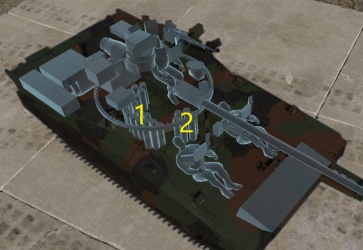
| Full ammo |
1st rack empty |
2nd rack empty |
Visual discrepancy |
|---|---|---|---|
| 26 | 7 (+19) | 1 (+25) | No |
Notes:
- Rack 2 is a ready rack, so although shells deplete from that rack after firing, it will refill from rack 1.
Machine guns
The HSTV-L has 2 M240 machine guns. One is fixed to the gun mantlet and the other is mounted on the Commander's cupola. These machine guns can be used to mark enemies for your allies and can also be used to shoot down some lighter aircraft, but be careful as shooting them will give away your location and can result in them strafing and destroying your vehicle.
| 7.62 mm M240 | ||||
|---|---|---|---|---|
| Mount | Capacity (Belt) | Fire rate | Vertical | Horizontal |
| Coaxial | 1,600 (200) | 941 | N/A | N/A |
| Pintle | 1,600 (200) | 941 | -10°/+69° | -180°/+20° |
Usage in battles
The HSTV-L is a light tank with a quick ready-rack reload, making it adept at dealing with multiple enemies in ambush situations. It can achieve a very good top speed thanks to its light weight and has a similarly good turning ability. With this mobility (which is on par with that of top MBTs), the HSTV-L can achieve desirable early-game positions and move quickly around the map when necessary.
Like most light tanks, this vehicle is lacking in the protection department. It has thin armour in all directions, which is not backed up by any spaced or composite protection, and is susceptible to overpressure damage. In some situations, the armour may be thin enough that kinetic rounds overpenetrate and pass straight through the vehicle without causing much damage. The highly-angled armour can also sometimes bounce shots. In most cases though, the HSTV-L cannot be counted on to sustain heavy fire.
This tank is fairly unique in that it is equipped with an autoloader that can fire every 1.5 seconds, without ever needing to stop to replenish a ready-rack.The shell itself, an APFSDS round, is decent, but may have trouble penetrating the frontal armour of top MBTs. This combined with the vehicle's poor armour means that head-on attacks are rarely advisable, but with the quick reload, multiple shots into an enemy's sides or rear will be very effective.
The HSTV-L is better suited to firing at enemies without their noticing--from ambush positions, from the flanks, and from behind corners. The vehicle's great mobility will aid with this playstyle. Indeed, its mobility is what makes the HSTV-L great on urban maps. Furthermore, in ambush situations the tank is able to easily deal with multiple enemies thanks to its fast ready-rack reload. This tank has a 45 degree gun elevation and a 17 degree gun depression. This gun depression is extremely powerful, and makes the vehicle very effective at hill camping and at firing from behind ridgelines. A thermal sight in both gunner and commander/binocular views makes the HSTV-L a great scouting vehicle. It is recommended to use the vehicle's high mobility to aid in scouting enemies for teammates to locate and destroy.
Pros and cons
Pros:
- Thanks to the autoloader, the cannon has a very high rate of fire
- Due to its light armour some kinetic rounds may over penetrate, leaving it undamaged
- Excellent in urban combat where side shots are much more effective
- Internal 5 mm armour can help protect crew from spalling
- Thermal sights for both the gunner and the commander make it a great scouting vehicle especially with its scout UAV, also with thermals
- Its scout UAV has better thermals than the HSTV-L itself
- Up to 45° elevation and -30° depression over the sides (-17° depression to the front, -6° depression when facing rear)
- Very good gun handling
- Turret has only one crew member, the commander, and the breech is small
- Excellent mobility, allowing it to keep up with and even outpace MBTs
Cons:
- Commander's cupola can be penetrated by heavy machine gun fire
- Limited ammo selection and capacity
- APFSDS round has low penetration and has problems penetrating frontal armour of some MBTs
- The XM855 APFSDS dart causes minimal damage to modules or crew members after penetration due to its calibre (reduced spall)
- Prone to overpressure
- Does not have access to a heavy machine gun
History
Development
The High Survivability Test Vehicle - Lightweight, shortened to HSTV-L, was a light tank project that was developed in the 1970s and 1980s. It was funded by the Defense Advanced Research Projects Agency (DARPA) and built by the AAI Corporation. The prototype was completed in September 1979 and began field trials soon after. After the field trials the HSTV-L was used for testing of the fire control system (FCS) with different stabilization algorithms tested as well as the hunter-killer sights. The HSTV-L was not chosen for production by the Army or the Marine Corps and was cancelled in 1981. It was later developed into the Rapid Deployment Force Light Tank (RDF/LT).
Design
General
The HSTV-L design was based around an incredibly low profile hull and turret with very shallow angles on the frontal portion, in order to deflect projectiles fired at it. The HSTV-L had a crew of 3, with the driver and gunner side by side in the hull front and the commander in the left side of the turret, all of whom sat semi-reclined. All 3 crew members had the ability to fire the gun and both the gunner and driver's position could drive the vehicle. The vehicle had a length of 8.528 m with gun forward and the hull had a length of 5.918 m. The height was only 2.414 m including the equipment on the turret roof, being 1.994 m to the top of the turret and 1.422 m to the top of the hull. The width was 2.794 m. The vehicle had a combat weight of 14.5 tonnes or up to 17.0 tonnes when equipped with an appliqué armour package. During testing the HSTV-L was fitted with additional equipment for data collection and weighed 20.45 tonnes. The HSTV-L could be airlifted, underslung, by a CH-53 Sea Stallion helicopter when at the weight of 14.5 tonnes.
Mobility and Power
The HSTV-L was propelled by a 650 horsepower (485 kilowatt) Avro-Lycoming gas turbine powerplant and an Allison X-300-4A transmission with four forward and two reverse gears. The transmission had a torque converter. There were five road wheels on each side and the tracks were 450 mm wide. The suspension was built by National Water Lift, being hydropneumatic but not variable; in other words the height could not be adjusted. The ground clearance of the HSTV-L was 0.508 m. The HSTV-L could pivot in place while in neutral gear, and it carried a fuel load of 409 liters giving it a cruising range of 160 km. It could accelerate from 0 to 48 km/h in 11.8 seconds and had a maximum speed of 83.68 km/h.
In addition to the main propulsion system there were two 250 ampere generators providing auxiliary power as well as a 60 gpm hydraulic pump. The hydraulic pump was used to power an oil cooler fan mounted in the engine compartment as well as the gun control system and automatic loading system.
Armament and FCS
The main armament of the HSTV-L was an ARES 75 mm XM274 gun mounted in a rotating turret. 26 rounds of ammunition were provided of both depleted-uranium APFSDS-T and multi-fléchette anti-aircraft rounds. The gun was loaded by an automatic loading system which provided the HSTV-L with a high rate of fire.
Secondary armament was provided by a coaxial 7.62 mm M240 machine gun and a second 7.62 mm M240 machine gun pintle-mounted on the commander's cupola. A total of 3,200 rounds of 7.62 mm ammunition was split between the two machine guns.
The turret could rotate a full 360 degrees at a speed of 57 degrees per second. The gun could elevate 45 degrees but the depression depended on which direction the turret faced; over the front the gun could depress 17 degrees, 30 degrees over the side, and 6 degrees over the rear of the vehicle. Manual backup was provided for turret traverse and gun elevation but the rate at which they moved was much slower when manual than with power. The main gun was two-plane stabilized, with both the stabilization and gun control systems having been produced by Cadillac Gage.
The hunter/killer fire control system (FCS) was designed and built by Texas Instruments. The commander received a stabilized commander's independent thermal viewer (CITV) which could rotate independently of the turret and included both TV and thermal imaging. The gunner also received a stabilized sight, though this one was slaved to the gun, which included thermal and TV imaging as well, along with an eye safe CO2 laser rangefinder built by Raytheon. This hunter/killer system allowed the commander to locate a target with the hunter sight. Once a target was located the gunner would use his killer sight to fire on the target while the commander began to search for the next target. The fire control system (FCS) used the sights, crosswind sensor, muzzle reference system, vertical reference system, and laser rangefinder to automatically determine the firing solution, leaving the gunner only to fire the gun. The fully stabilized main gun along with advanced FCS allowed the HSTV-L a high first hit probability and high accuracy on the move.
The driver and gunner are given a screen that displays the imaging of the hunter sight which allows them to operate independently of a vehicle commander if necessary. Theoretically, the HSTV-L could be controlled entirely by only one crew member from either the driver or gunner's position since both had driving and gunnery controls.
Devblog
By the mid 1970s, the US military initiated a series of studies which looked into the development of new concepts and designs for tanks which combined good firepower and survivability. The latter of which was to be achieved through a smaller size, rather than heavy armour protection.
As at the time, both the US Army and USMC were looking into possible replacements for their M551 Sheridan and M50 Ontos tanks respectively, the two military branches joined forces in a joint research programme dubbed "ARMVAL" (Advanced Antiarmor Vehicle Evaluation). The vehicles developed under this programme would be used as test beds for various new concepts and ideas in an effort to gain new experiences, which would in turn be used in the development of future tank designs.
One of the later products of this experimental programme was the HSTV-L - a compact, lightweight, highly mobile tank design, fitted with an autoloaded 75 mm smoothbore cannon, designed to fire kinetic ammunition in short bursts in order to wear down and ultimately defeat composite armour screens. The HSTV-L was built in 1979 and underwent various trials until 1981.
At the start of the 1980s, the 75 mm gun was considered inadequate to deal with the most recent Soviet MBTs by the Army, while the USMC questioned the vehicle's effectiveness in amphibious landing operations. This led to the ultimate discontinuation of the collaborative project in 1981.
Media
- Skins
- Images
- Videos
See also
- Light tanks at similar positions in other tech trees
External links
| Aircraft Armaments Incorporated (AAI) Corporation | |
|---|---|
| Light tanks | T92 · HSTV-L |
| USA light tanks | |
|---|---|
| LVT | LVT(A)(1) · ○LVT(A)(1) · LVT(A)(4) |
| M2 | M2A2 · M2A4 · M2A4 (1st Arm.Div.) |
| M3/M5 Stuart | M3 Stuart · M3A1 Stuart · M3A1 (USMC) · M5A1 · M5A1 TD · ▃Stuart VI (5th CAD) |
| M22 Locust | M22 |
| M24 Chaffee | M24 · M24 (TL) |
| M18 Hellcat | M18 GMC · M18 "Black Cat" · Super Hellcat |
| M41 Walker Bulldog | M41A1 |
| M551 Sheridan | M551 · M551(76) |
| M3 Bradley | M3 Bradley · M3A3 Bradley |
| Wheeled | M8 LAC · T18E2 · M1128 · M1128 Wolfpack |
| Other | M8A1 GMC · T92 · T114 · HSTV-L · CCVL · XM8 · XM800T · AGS |



